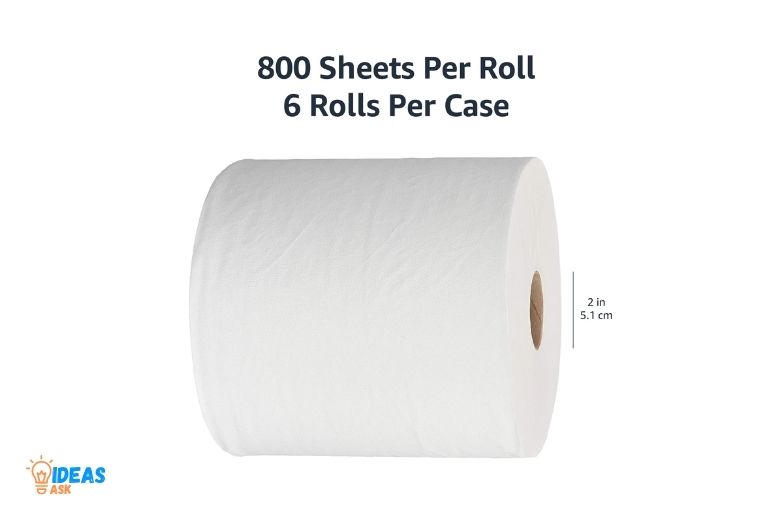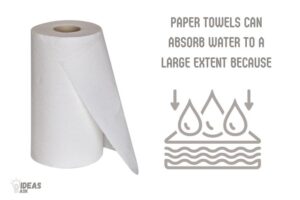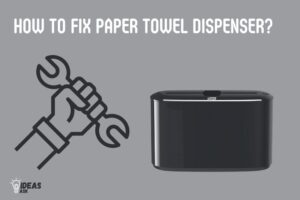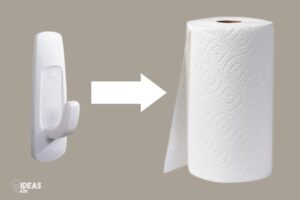How Thick is a Paper Towel Roll? 1.5 to 2 inches!
A standard paper towel roll typically has a thickness of around 1.5 to 2 inches.
Paper towel rolls come in various sizes, depending on the brand and type. The thickness of a paper towel roll refers to the diameter of the cardboard tube inside the roll.
The thickness is influenced by the number of sheets, the type of paper used (1-ply, 2-ply, etc.), and the overall dimensions of the roll.
The thickness of a paper towel roll not only impacts its overall dimensions, but it also affects its absorbency and durability.
Thicker rolls with more sheets or multiple plies can provide greater absorbency, while thinner rolls may be more suitable for lighter, everyday tasks.
Ultimately, the thickness of a paper towel roll will depend on the specific needs and preferences of the user.
Thickness of Different Brand Paper Towel Rolls
| Brand | Thickness of a Single Sheet (inches) | Thickness of a Full Roll (inches) |
|---|---|---|
| Bounty | 0.002 | 1.5 |
| Brawny | 0.002 | 1.4 |
| Viva | 0.0025 | 1.6 |
| Scott | 0.0015 | 1.3 |
| Sparkle | 0.002 | 1.5 |
Key Takeaway

Five Facts About Thickness of Paper Towel Rolls
Why Paper Towel Thickness Matters
When considering paper towel rolls, the thickness of the roll is a crucial factor to consider. The thickness affects not only the performance of the paper towel but also its cost.
Here are some of the reasons why paper towel thickness matters:
Importance For Cleaning And Absorbency
The thickness of a paper towel roll determines its ability to clean and absorb effectively.
Here’s how:
- Thicker paper towel rolls with a higher gsm (gram per square meter) are highly absorbent and can clean better than thinner ones with a lower gsm.
- Such towels are better at picking up spills, wiping surfaces and absorbing moisture.
- Thick paper towels can retain their structural integrity when wet, making them more efficient in cleaning up larger messes.
While it’s tempting to save money by buying thinner paper towels, using thick paper towels is worth the investment as they can clean and absorb more dirt and moisture.
Cost Considerations
The cost of paper towels with different thicknesses can vary significantly.
Here are a few cost considerations to keep in mind:
- Thick paper towels with better absorbency and cleaning power tend to be more expensive compared to thinner ones which may be cheaper but may come with trade-offs in performance.
- Consider buying paper towels in bulk if you want to save money; you’ll get more towels for less money this way.
- Some companies offer paper towels with half-sized sheets, which can save money and reduce environmental impact by minimizing waste.
When buying paper towels, keep in mind the thickness of the roll and what you need them for. While thick paper towels may cost more, their absorbency and cleaning capabilities make them a smart investment.
How Paper Towel Thickness Is Measured
If you’ve ever wondered how thick a roll of paper towels is, you’re not alone. The thickness of a paper towel may not seem like a big deal, but it is a factor that affects their absorbency and durability.
Here’s everything you need to know about how paper towel thickness is measured.
Overview Of Industry Standards
Before we dive into the nitty-gritty of measuring paper towel thickness, let’s take a moment to discuss the industry standards that govern this process.
The american society for testing and materials (astm) has established a set of guidelines for measuring the caliper of paper products, which includes paper towels.
Caliper refers to the thickness of a sheet of paper, measured in thousandths of an inch or microns. These guidelines ensure that paper towels are measured consistently across the industry.
Explanation Of Caliper Measurement
Caliper measurement is the most commonly used method to measure the thickness of paper towels. To determine the caliper of a paper towel roll, a small section is cut from the roll and placed between two plates.
Pressure is applied to the plates until the roll becomes compressed, and its thickness is measured. This measurement is known as the caliper, and it’s usually expressed in units of thousandths of an inch.
Caliper is an important factor in determining the strength and absorbency of paper towels, although it’s not the only factor that affects their performance.
Comparison Of Caliper Measurement To Other Thickness Measurements
While caliper measurement is the most common way to measure the thickness of paper towels, there are other methods as well.
Here are a few examples:
- Basis weight: This refers to the weight of a sheet of paper, measured in pounds per 500 sheets. Basis weight is not as commonly used for paper towel rolls, as their size and weight can vary greatly.
- Micrometer measurement: This method involves using a micrometer to measure the thickness of a paper towel roll. This measurement is usually expressed in microns, which is equivalent to thousandths of a millimeter.
While these methods are less common than caliper measurement, they can still be useful in certain situations.
Caliper measurement remains the most widely used method, however, due to its consistency and accuracy.
Understanding how paper towel thickness is measured is an important factor in assessing their absorbency and durability.
Caliper measurement is the most commonly used method and is governed by industry standards to ensure consistency.
While other methods exist, caliper measurement remains the most reliable and informative way to determine the thickness of paper towel rolls.
Factors Affecting Paper Towel Thickness
Paper towels are common household items that have a variety of uses, such as drying hands, cleaning spills, and wiping surfaces. The thickness of a paper towel roll is a key factor in its absorbency and durability.
There are several factors that affect paper towel thickness, including the materials used, the manufacturing process, and quality control measures.
Materials Used
The materials used in manufacturing paper towels play a significant role in determining their thickness.
Some common materials used in the production of paper towels include:
- Virgin pulp: This refers to paper made directly from wood fibers. Virgin pulp is known to have a high-quality and thickness.
- Recycled pulp: This refers to paper made from recycled paper. The thickness of recycled pulp may vary depending on the source and method of recycling.
- Additives: Manufacturers may add substances such as glue, wax, or chemicals to increase the thickness and strength of paper towels.
Manufacturing Process
The manufacturing process of paper towels also affects their thickness.
The two common methods of manufacturing paper towels include:
Wet-laid process
This method involves suspending cellulose fibers in water, forming a wet pulp.
The pulp is then pressed between rollers to remove excess water, dried, and rolled into paper towels. This method produces paper towels with a higher thickness and absorbency.
Air-laid process
This method involves blowing cellulose fibers into the air, creating a web of fibers.
The fibers are then bonded together with water or heat. This method produces paper towels with a lower thickness and absorbency.
Quality Control Measures
Quality control measures are an essential aspect of manufacturing paper towels. Manufacturers employ several measures to ensure the thickness and quality of paper towels.
Some of these measures include:
- Grammage: Manufacturers measure the weight of paper towels per square meter to determine their thickness and durability.
- Moisture content: Manufacturers use moisture meters to measure the amount of moisture in paper towels. Excessive moisture can reduce the thickness of paper towels.
- Caliper: Manufacturers measure the thickness of paper towels using a caliper. This helps to ensure consistency in thickness.
- Tensile strength: Manufacturers test the tensile strength of paper towels to ensure they can withstand tearing and stretching.
The thickness of paper towel rolls is determined by several factors, including the materials used, the manufacturing process, and quality control measures.
Manufacturers use different techniques to produce high-quality paper towels with varying levels of absorbency and thickness.
By understanding these factors, consumers can make informed decisions when purchasing paper towels.
The Standard Thickness Of A Paper Towel Roll
When it comes to household essentials, paper towels are a must-have. They are convenient and disposable, making cleaning up spills and messes a breeze.
But have you ever wondered how thick a paper towel roll is? We will discuss the standard thickness of a paper towel roll, as well as compare the thickness across different brands and types of paper towels.
Overview Of Common Thickness Measurements
Paper towels are available in various sizes and thicknesses, depending on their intended use.
These are the most common thickness measurements you’ll come across in the market:
- Single-ply paper towels: This type of paper towel is thinner and more delicate compared to its counterparts. Although they are affordable, they are not the most absorbent or durable.
- Double-ply paper towels: They are two-ply or thicker, which makes them more absorbent than their single-ply counterparts. They can handle spills and messes more efficiently and are more durable. They are more expensive, but it’s worth the price for the quality.
- Multi-ply paper towels: These are paper towels made up of multiple layers of paper. They have the highest absorbency and durability, making them ideal for commercial use.
Comparison Of Thickness Across Different Brands And Types Of Paper Towels
There is a wide range of paper towels brands and types available on the market, and each has its unique qualities.
Here are some of the popular brands and their thickness measurements:
- Bounty: Bounty paper towels are thicker and more absorbent than other brands. They are available in single, double, and triple-ply thickness options.
- Viva: Viva paper towels are soft and have a cloth-like texture. They are 2-ply and provide great absorbency and durability.
- Scott: Scott paper towels are thinner compared to other brands. They are available in 1 and 2-ply options, making them affordable and budget-friendly.
- Kleenex: Kleenex paper towels are soft, thick, and absorbent. They are available in single and double-ply options.
- Brawny: Brawny paper towels are thickest among all the brands. They are available in 2, 3, and 6-ply options, making them a great choice for heavy-duty cleaning.
The Average Thickness Of A Paper Towel Roll
The thickness of a paper towel roll depends on factors such as the type of paper used, the number of plies, and the manufacturing process. On average, a single-ply paper towel roll has a thickness of 0. 35 – 0.
5 mil, while a double-ply paper towel roll can have a thickness of 0. 7 – 1 mil. It’s important to note that the thickness of paper towels may vary depending on the brand and manufacturing process.
It’s always best to choose a quality brand that provides the desired level of thickness and absorbency.Understanding the thickness of a paper towel roll is essential when choosing the right paper towel for your needs.
Depending on the brand and type, paper towels can vary in their thickness, absorbency, and durability. Choose a paper towel that suits your needs, and always look for quality when selecting household essentials.
Variations In Paper Towel Roll Thickness
Paper towel rolls are a common household item that plays a vital role in cleaning up spills, wiping countertops, and even drying hands.
While the actual usage of paper towels is pretty much straightforward, the thickness and quality of paper towel rolls might vary.
Let’s dive deeper into the topic of paper towel rolls’ thickness, the variations in it, and how it can impact their performance and cost.
Causes Of Variations
The thickness of paper towel rolls can vary based on several factors, including:
- Ply count: The number of plies or layers in a roll determines its thickness. Generally, paper towel rolls have one to three plies. A one-ply roll might be thinner than a two- or three-ply roll.
- Pulp: Pulp is used to make paper towel rolls, and different types of pulps can result in variations in thickness.
- Manufacturing process: The paper towel rolls’ manufacturing process can affect their thickness, for example, the pressure applied to the pulp during manufacturing.
How Variations Can Affect Performance
The thickness of a paper towel roll can affect its absorbency, strength, and durability.
Here’s how:
- Absorbency: Thicker paper towel rolls tend to be more absorbent than thinner ones. Two- or three-ply paper towel rolls can absorb larger spills more efficiently than one-ply rolls.
- Strength: The thickness of a paper towel roll is directly proportional to its strength. A thicker paper towel roll is less likely to tear easily than a thinner one.
- Durability: The thickness of a paper towel roll also impacts its durability. A thicker paper towel roll can withstand more wear and tear than a thinner one.
Understanding The Impact Of Variation On Cost
The thickness of paper towel rolls, along with other factors such as brand and total number of rolls per pack, can impact their cost. Generally, thicker paper towel rolls tend to be more expensive than thinner ones.
Here are some things to keep in mind when it comes to the cost of paper towel rolls:
- Thicker paper towel rolls might offer better performance than thinner ones, but they also come at a higher cost.
- If you use paper towel rolls frequently and need them for heavy-duty cleaning tasks, investing in a thicker roll might be a better value in the long run.
- However, if you don’t use paper towels frequently or need them for lighter cleaning tasks only, thinner paper towel rolls might be a more cost-effective option.
The thickness of paper towel rolls can vary based on factors such as ply count, pulp, and manufacturing process.
Thicker paper towel rolls generally offer better performance in terms of absorbency, strength, and durability, but they also come at a higher cost.
Understanding these variations can help individuals choose the best paper towel rolls suited for their needs while balancing cost and performance.
FAQ On Paper Towel Roll Thickness
How Many Sheets Are In A Paper Towel Roll?
The number of sheets in a paper towel roll varies depending on the brand and thickness. On average, a roll has 50-100 sheets.
What Is The Standard Size Of A Paper Towel Roll?
A standard-size paper towel roll has a width of 11 inches and a diameter of 5. 2 inches.
What Is The Thickness Of A Paper Towel Roll?
The thickness of a paper towel roll varies depending on the brand and quality. On average, the thickness ranges between 0. 01-0. 03 inches.
What Factors Affect The Thickness Of A Paper Towel Roll?
The thickness of a paper towel roll is affected by the quality of the paper, the manufacturing process, and the number of plies. The higher the quality, the thicker the roll.
Conclusion
Paper towel rolls are a common feature in most households. They are essential for cleaning up spills, drying hands and cleaning surfaces. Knowing the thickness of a paper towel roll is important when making a purchase.
In this article, we have explored the different thicknesses of paper towel rolls and how to determine the right thickness for your needs.
We have learned that paper towels come in different thicknesses ranging from single-ply to multi-ply. The thickness of a paper towel roll is determined by the number of plies and the weight per square foot.
In addition to thickness, other factors to consider when choosing a paper towel roll include strength, absorbency, durability, and cost-effectiveness.
To make an informed decision, it is important to understand your needs and choose a paper towel roll that meets them. Remember, the thickness of a paper towel roll is just one factor to consider. Happy cleaning!





